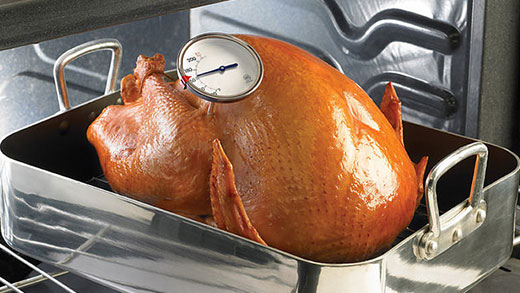
A food thermometer is the best way to determine if food is cooked properly.
Food thermometer is essential tool when cooking at home
And K-State food safety expert says it might make you a better cook, too
Sept. 14, 2020
MANHATTAN, Kan. – As a tool, a food thermometer makes a pretty handy line of defense in the kitchen. And it might even make you a better cook.
Kansas State University food safety specialist Karen Blakeslee said a thermometer is most often thought of as an indicator that food is cooked to an internal temperature that decreases the risk of foodborne illness.
“But,” she added, “it can help benefit the quality of the product in the end, too, because it helps you from over-cooking foods.”
Blakeslee promotes safely preparing foods year-round, but especially in September, which is recognized as Food Safety Education month.
For most meats, the important internal cooking temperatures to remember include:
- 145 degrees F for steaks, roasts and chops.
- 160 F for all types of ground meat, except poultry.
- 165 F for all poultry, including whole birds.
“You only have to get the internal temperature up to that level for about 30 seconds,” Blakeslee said. “When you think it’s done, check the temperature and clean the thermometer so it is clean each time you use it.”
A food thermometer can be used on many foods, Blakeslee said. It’s especially useful for leftovers, which also should be reheated to 165 F before eating.
Some other food safety tips that Blakeslee shared include:
- Divide leftovers into small containers, about two inches deep, before storing so that they chill faster. It also makes a more convenient meal later on.
- Be aware of food that has been recalled. The U.S. Food and Drug Administration routinely announces recent recalls, which happen nearly every day. It is best to throw away the recalled food, or take it back to the store where you purchased it for a refund.
- Store leftovers within two hours, or within one hour if you are outside and it is hot. Keep foods out of what is commonly known as the ‘danger zone’ – or between 40 F and 140F. Keep cold foods cold, and hot foods hot.
- Rinse produce with plain water. Do not use bleach or other cleaning solutions. Use a scrub brush if necessary, or rub with your fingers on the cracks and crevices. Meat should not be washed before cooking.
- Wash your hands, something Blakeslee said is the first defense of handling any kind of food. You will likely need to wash your hands several times while preparing a meal.
Find more information on food safety through K-State’s Rapid Response Center, or through K-State Research and Extension’s food safety website.

